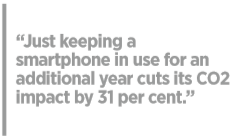CellDe's editorial written by our CEO / Managing Director- Ankur Thakur for Mobile World Live - An event preview of MWC Barcelona 2020. With due regard to the safe and healthy environment in Barcelona and the host country, GSMA decided to cancel MWC Barcelona 2020 due to the global concern regarding coronavirus outbreak, travel concern and other circumstances.

Why do buyback businesses fail?
The overall market is expected to reach an estimated $52.7 billion by 2022, and each phone will sell for an average of $180. This growth can be accredited to an uptick in demand for used smartphones that offer significant savings compared with new models. About half of the devices purchased new end up having three or more owners before being retired. Just keeping a smartphone in use for an additional year cuts its CO2 impact by 31 per cent. These are then traded-in to manufacturers, carriers or sold online privately in exchange for cash or credit towards a new smartphone. A growing number of independent trade-in businesses are competing for old mobile devices on the ease, trust, and reliability of their service. Manufacturers are also in this race, with Apple and Samsung at the forefront. However, the second-hand trade-in ecosystem has its own complexities. As they go through the entire cycle of sourcing, processing and remarketing each device, they have to make sure it’s fit to be reused. There are several things that anyone running or planning to launch a buyback business must be careful of.
1.CASHFLOW: Device buyback is typically a negative cashflow trade because you payout for a device well before the same can be sold to recover value and make profit. By making a few adjustments like extended payment terms or selective modes of payout like gift card, bill credits can help shorten the time between the actual payables and receivables and in some cases even lead to positive cash flow.
2.INSTANT GRATIFICATION: While most buyback businesses are tempted to offer on-the-spot credits to boost sales but it comes with its own risks. Making instant payment opens the system for fraud. For instance, a recently stolen device could be immediately sold at a retail buyback store offering instant cash before the owner had the chance to get the device blacklisted causing loss later. We recommend payouts to happen only after receipt and inspection at the warehouse. Alternatively business can enforce sellers to provide a proof of ownership or photo-ID that can help address the underlying issue.
3.MANAGING VARIANCE While doing a trade-in, online customers are quoted a value based on conditional questions but more often than not there are discrepancies between the condition stated and what the business receives. Cases where businesses have to diagnose hundreds and thousands of devices every day, automated mobile device diagnostic solutions that test unique functions to determine the internal health of a device are the key to success. It's beneficial to use solutions that provide standard diagnostics both in the customer facing portal and the warehouse system which mitigates discrepancies. These solutions standardise the examination of hardware and software features with precise metrics, as opposed to being left to the subjective opinions of human testers.
4.MANAGING ONLINE REPUTATION With the growing popularity of social media,
third-party reviews websites, blogs, and other digital platforms, maintaining a solid online reputation is necessary for every business. In the buyback realm several factors can help to keep a positive word of mouth such as:
- Accurate and objective diagnostics (helps to keep quoted price same as final paid price)
- Quick payments after device condition verification
- Offer complete order visibility
- Provide evidence in case of conflicts, for example photos of the received device.
5.DATA SECURITY CONCERNS Mobile devices store a considerable amount of sensitive data including business and personal information. While most users think that performing a factory reset wipes all data from the device, unfortunately, it still leaves data hidden in there, which can be retrieved from most of the factory-reset smartphones using commercially available recovery software and lead to data breaches. To safeguard themselves of legal complications involved, buyback businesses that deal with hundreds of devices every day, require industrial data wiping solutions certified by reputed agencies like ADISA.
6.LOCKED, BLOCKED AND STOLEN DEVICES iCloud, Google, passcode lock, financed, blacklisted, fake IMEIs, jailbroken or rooted devices can be just a few examples of phones you end up bringing in to your business if your buyback solution isn't composed of extensive security features and processes to deter the purchase of any such device. These devices are a total loss to the business and can only be salvaged for parts. To protect your investments and provide frictionless customer experience, your approach to prevent flagged devices from

entering the business stream must be holistic and proactive. This means getting the right solutions in place that can detect such devices automatically and approve or decline transactions at scale, leaving a very small percentage that require manual review.

7.UNAUTHORISED REPAIRS AND NON-OEM SPARE PARTS Demand for cheaper, more accessible repairs has led to a thriving independent repair community and a huge market for unofficial, aftermarket parts that's entirely unregulated. While OEM parts are expensive, cheaper substitutes are of low quality. Devices with non-OEM parts have significantly low resale value as compared to devices with OEM parts. This very recently led to slashed tradein prices for iPhone upgraders by as much as 17 per cent mid-cycle. Apple’s buyback provider found a lot of devices that had original Apple parts harvested and replaced with third party parts causing an irrecoverable loss to the business. Ever than before, buyback businesses require robust solutions that can detect these cheap substitute for OEM parts fitted in traded devices and control the losses. This unfortunately doesn’t have any automated solution which can work quickly without dismantling the device. However some companies are working to create products that can handle these so hopefully in future we may have a solution.
